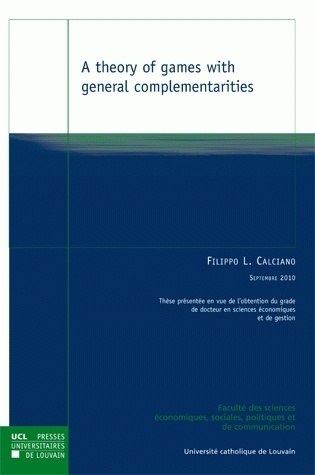A Theory of games with general complementarities
Première édition
In the current theory of games, the formal notion of complementarity that is employed is unsatisfactory because it bears too few connections with our intuitive idea of complementarity. This is the starting point of the present... Lire la suite
The current theory of games with strategic complementarities, also know as supermodular or quasisupermodular games, sets up a fundamental tool to investigate strategic interactions where diffuse Pareto-Edgeworth complementarities among the actions of the agents are present. It represents the basic analytical framework for modern industrial organization, and finds plenty of applications in strategic macroeconomics and in microeconomics at large.
However, the formal notion of complementarity that is employed in this theory is unsatisfactory because it bears too few connections with our intuitive idea of complementarity. This is the starting point of the present work.
We introduce a notion of complementarity that is more meaningful from an economic point of view, and investigate how far we can go from it. We define a new class of games, that we call games with general complementarities, and obtain for these games results in terms of existence of greatest and least Nash equilibria, comparative statics of these extremal equilibria, lattice structure of the Nash set, and rationalizability of Nash profiles.
Our games with general complementarities retain many of the basic properties of games with strategic complementarities. In the presence of this, our work represents a generalization of the latter class of games
Games with strategic complementarities are a mathematical construction that merges an order-based fixpoint theory, in the vein of Tarski, with an approach to comparative statics for payoffs defined on lattices, independently developed in operations research. To attain our results, we have generalized both the fixpoint part of the theory of games with strategic complementarities and its comparative statics part. These intermediary results have their own independent interest.
We present applications of our games with general complementarities to models of search and models of oligopoly, problems that are not tractable with standard tools.
Spécifications
- Éditeur
- Presses universitaires de Louvain
- Partie du titre
-
Numéro 631
- Auteur
- Filippo L. Calciano,
- Collection
- Thèses de la Faculté des sciences économiques, sociales, politiques et de communication
- Langue
- anglais
- BISAC Subject Heading
- BUS000000 BUSINESS & ECONOMICS
- Code publique Onix
- 06 Professionnel et académique
- CLIL (Version 2013-2019 )
- 3283 SCIENCES POLITIQUES
- Description public visé
- Économistes
- Date de première publication du titre
- 01 septembre 2010
- Type d'ouvrage
- Thèse
- Avec
- Bibliographie
- Langue originale
- anglais
Livre broché
- Date de publication
- 01 septembre 2010
- ISBN-13
- 9782874632433
- Ampleur
- Nombre de pages de contenu principal : 80
- Dépôt Légal
- D/2010/9964/42
- Code interne
- 83340
- Format
- 16 x 24 x 0,5 cm
- Poids
- 143 grammes
- Prix
- 10,50 €
- ONIX XML
- Version 2.1, Version 3
Google Livres Aperçu
Publier un commentaire sur cet ouvrage
Sommaire
Acknowledgments i
Preface v
Chapter 1. The Mathematics of Complementarity 1
1. Introduction 1
2. Cardinal and ordinal complementarity 2
3. Cardinal versus ordinal complementarity 6
4. Monotone comparative statics on chains 8
5. Monotone comparative statics on finite products of chains 9
6. Monotone comparative statics on lattices 14
7. Applications to Cournot and Bertrand competition 18
Chapter 2. Fixed Points of Increasing Correspondences 21
1. Introduction 21
2. Background material on lattices 21
3. Increasing correspondences 22
4. Extremal fixpoints and their comparative statics 24
5. Order structure of the fixpoint set 28
Chapter 3. A Theory of Comparative Statics with General Complementarities 33
1. Introduction 33
2. Generalized modularity and generalized increasing differences 35
3. Quasilattices 40
4. Comparative statics of optimal solutions 47
Chapter 4. Games with General Complementarities 53
1. Introduction 53
2. The standard games with strategic complementarities and their properties 53
3. Games with general complementarities and their properties 55
4. Sufficient conditions on payoffs 56
5. Rationalizability 58
6. Application: A Diamond-type search model 60
7. Application: Oligopoly theory 62
References 67

